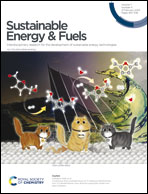A high-energy hybrid lithium-ion capacitor enabled by a mixed capacitive-battery storage LiFePO4 – AC cathode and a SnP2O7 – rGO anode†
Abstract
In this work we present the development and optimization of a graphene-embedded Sn-based material and an activated carbon/lithium iron phosphate composite for a high-performing hybrid lithium-ion capacitor (LIC). For the negative electrode, we have synthesized and screened different tin and phosphorus-based graphene materials based on the chemical structure, morphology and particle size, selecting a composite consisting of nano-sized crystalline tin pyrophosphate (SnP2O7) particles embedded in a graphenic matrix. For the positive electrode, a composite combining a high-loading (40 wt%) faradaic material lithium iron phosphate (LFP) with a graphene-activated carbon was developed whereas other bi-material cathodes are limited to about 20 wt% of faradaic material. The homogeneous distribution of nanosized carbon-coated LFP particles along the graphene-activated carbon has enabled energy storage via faradaic, pseudocapacitive, and capacitive mechanisms. The optimized-electrode LIC delivers high energy densities and overcomes the main power limitations of LICs using high-content battery-type materials (143 Wh kg−1 at 128 W kg−1 and 45 Wh kg−1 at 25 000 W kg−1).

- This article is part of the themed collections: Recent Open Access Articles and Hybrid Ion Capacitors


 Please wait while we load your content...
Please wait while we load your content...